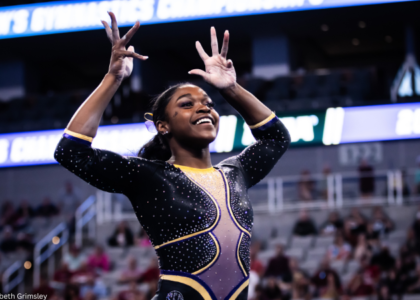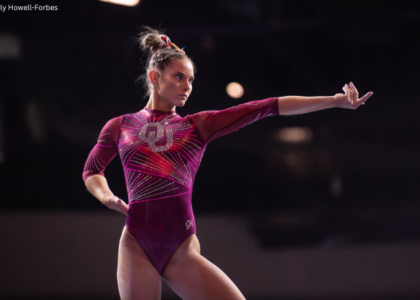Florida won the 1982 AIAW championship title, the final collegiate women’s gymnastics championship held under that association’s banner. The Gators would not earn another national title until 2013 when it won the first of three consecutive NCAA championships. However, the years since have been more disappointing.
“This team has been through so much adversity through this year, and today is not what the Gators know that they’re capable of doing. However, what they’ve done throughout this entire season is something that cannot be taken away from them, and they have a lot to be proud of,” Florida head coach Jenny Rowland said at the conclusion of the 2021 NCAA championships in which her team finished fourth, though her words could seemingly apply to several of the team’s recent postseason finishes.
Prior to its three-peat, Florida was a solid presence in postseason competition but by no means a major title threat. After finishing a disappointing 14th in 2000, the Gators remained firmly in the top 10 from 2001 to 2011 before jumping from seventh to second in 2012, the program’s best finish since 1998. By comparison, Florida has finished outside of the top four only once since 2012, an admittedly disappointing 10th place finish in 2019 when the team failed to advance out of regionals.
The Gators were poised for a comeback in 2020, winning all nine of their meets and finishing the abbreviated season ranked second. That momentum carried over into 2021, where an undefeated Florida led the SEC and national rankings throughout the regular season. Late season injuries to key contributors—most notably to top-ranked all arounder Trinity Thomas—stretched the Gators’ already thin roster of 14, and their postseason performances lacked the polish and confidence from earlier in the year (notably, the team’s two lowest scores of the season came at the SEC championship and NCAA final).
Regardless of what the data actually indicates—and the data is inconclusive at best—gymnastics is a subjective sport, and the perception among a significant portion of college gymnastics fans is that the Gators have struggled in the postseason since their 2015 win.
With the 2022 season rapidly approaching, Florida fans are looking to its illustrious freshman class of Sloane Blakely, Riley McCusker, Leanne Wong and Bri Edwards, with Morgan Hurd and possibly Shilese Jones to follow in January, to change the team’s postseason fortunes. That hope is understandable, even inevitable, given the caliber of the gymnasts and their similarities to the 2013 team’s newcomer class. The scoring potential is undeniably high, and they’ve proven their collective mettle in high-pressure competition. While it’s tempting to think they’ll feature prominently and immediately in the team’s 2022 lineups, is that realistic?
Not necessarily. In 2013, 2008 Olympic silver medalist and 2009 world all around champion Bridget Sloan competed on at least three events for the entirety of her freshman season, but three-time national team member Bridgette Caquatto didn’t make her debut until late February and didn’t compete again until regionals when she stepped in for an injured teammate on floor. In 2015, two-time national team member Kennedy Baker competed in three or four events for the bulk of the season while her former national teammate and fellow freshman Grace McLaughlin competed a single beam routine.
The Gators are only losing one routine from last season, and it’s highly unlikely that Rowland would bench four lineups’ worth of experienced upperclassmen in favor of the freshmen, no matter how skilled. On the other hand, the sheer volume of talent will have to be utilized. Are we likely to see significant freshman contributions in 2022? Yes. Are we going to see every freshman compete every event they’re training every week? Probably not.
Now, what the freshmen can realistically provide right off the bat is depth. The Gators currently have two lineups’ worth of gymnasts training each event, with the freshmen contributing a possible 14 routines even before factoring Hurd or Jones into the equation. That’s a significant buffer compared to last season, especially on vault where Florida had eight vaulters and only three reliable 10.0 start values (Wong and Blakely add a Yurchenko double twist and a Yurchenko one and a half, respectively, while Edwards has a clean, floaty Yurchenko full). That buffer becomes even more valuable if and when injuries or illness come into play, giving athletes more time to heal and less pressure to return to the competition floor as quickly as possible. Increased depth—not to mention fewer injured athletes—could be the key to bringing the national title back to Gainesville.
All in all, it’s simply too early to predict how the 2022 postseason will play out. Florida undeniably has an embarrassment of riches in both the freshmen and upperclassmen, but Rowland and her staff still have to figure out how to best utilize that wealth of talent and experience on the team. Given the potential of the current roster, though, this year is likely to be the one that determines whether the fans’ perception of a postseason problem is actually a reality.
READ THIS NEXT: A Q&A With GymChem, Creator of a New Fantasy Gymnastics Game for 2022
Article by Claire Billman
Like what you see? Consider donating to support our efforts throughout the year!





One comment